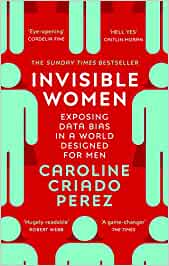Invisible Women: Exposing Data Bias in a World Designed for Men
For the category Economics of the 2022 NONFICTION READER CHALLENGE, I chose Invisible Women: Exposing Data Bias in a World Designed for Men, by Caroline Criado Perez, 2019.
Some
things I already knew: women earn less than men for the same work; women do
more unpaid work than men; women have fewer public toilet facilities, and medical
studies generally use only men or more men than women, so are not necessarily
relevant for women’s health (for example, heart attack symptoms).
But
there was so much more that I hadn’t realized – so much that the information
became rather depressing. For example, I hadn’t realized to what extent the
design of public spaces (streets, bus stops, public transportation routes, …)
is based on data from and about men.
As
Criado Perez writes at the end of the section with chapters relating to
different types of public spaces:
“These
are not niche concerns, and if public spaces are truly to be for everyone, we
have to start accounting for the lives of the other half of the world. And, as
we’ve seen, this isn’t just a matter of justice: it’s also a matter of simple
economics.”
There
is an entire section on how technology is designed with data only from and
about men. One example:
“Tech
developers even forget women when they form the potential majority of
customers. In the US, women make up 59% of people over the age of sixty-five
and 76% of those living alone, suggesting a potential greater need for
assistive technology like fall-detection devices. The data we have suggests
that not only do older women fall more often than men, they also injure
themselves more when they do. Data analysis of a month’s worth of emergency
department visits in the US found that of the 22,560 patients seen for fall
injuries, 71%, were women. The rate of fracture was 2.2 times higher in women,
and women had a hospitalisation rate 1.8 time that of men.
“And
yet despite women’s arguably greater need (as well as research indicating that
women tend to fall differently, for different reasons, and in different
places), gender analysis is missing from the development of this technology.”
The information for European countries is similar. Examples given throughout the book are from many areas of the world. And the book is very well researched, with a large section of references supporting each example.
Throughout
the book, Criado Perez comments refers to ‘male-default thinking,’ in which “human”
equals “male.” One of the explanations for why such bias against women exists
when they are 50% of the world is provided from the author’s interview with
Molly Crockett, associate professor of experimental psychology at Oxford
University.
“It’s
just a feature of human psychology to assume that our own experiences mirror
those of human beings in general. This is a concept in social psychology that
is sometimes called ‘naïve realism’ and sometimes called ‘projection bias’.
Essentially, people tend to assume that our own way of thinking about or doing things
is typical. That it’s just normal. For white men this bias is surely magnified
by a culture that reflects their experience back to them, thereby making it
seem even more typical. Projection bias amplified by a form of confirmation
bias, if you like. Which goes some way towards explaining why it is so common to
find male bias masquerading as gender neutrality. If the majority of people in
power are men – and they are – the majority of people in power just don’t see
it. Male bias just looks like common sense to them. But ‘common sense’ is in
fact a product of the gender data gap.”
This
leads to the realization that when women are more involved in decision-making
in all areas of life, their information and input are taken into account. And
this not only benefits women, but the economy and society as a whole.
In
the Preface, Criado Perez writes, “I will argue that the gender data gap is
both a cause and a consequence of the type of unthinking that conceives of
humanity as almost exclusively male. I will show how often and how widely this
bias crops up, and how it distorts the supposedly objective data that
increasingly rules our lives.” And she accomplishes this very well.


Comments
Post a Comment